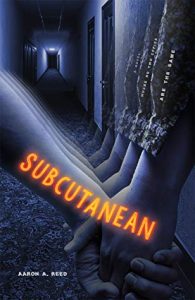
https://subcutanean.textories.com/
Reed is a winner of IndieCade’s “Best Story” award for game/book hybrid “The Ice-Bound Concordance,” and his text adventure “Blue Lacuna” has been named one of the Top Ten interactive fictions ever written. A long-time innovator in games and digital text spaces, Reed was a co-founder of interactive narrative technology company Spirit AI in 2016. When he started work on a traditional novel the following year, it was perhaps no surprise that it didn’t stay traditional for long.
“Gamers are used to the notion of stories that can change, and of wondering what might have happened if you’d made different choices or gone down other branches,” Reed says. “I was working on an unsettling psychological horror story about two friends trapped in an underground labyrinth filled with multiple realities and overlapping possibilities, and started wondering what it would be like to transpose that kind of quantum storytelling to a printed book. Not a book with explicit choices, but one where the choices were all made before your book was printed. You know you only have one version of the story, and feel this tension of wondering what other versions might be out there– just like the characters in the book.”
To create Subcutanean, Reed devised a custom syntax for authoring multiple versions of scenes that can coexist in one master text. While the book’s plot doesn’t branch– each version has the same core outline– the different versions can reveal unique details, enforce different narratorial styles, unfold in different locations, introduce alternate plot threads or characters, trigger setup or pay-offs in other chapters, and resolve the characters’ stories in different ways. In combination, this library of alternatives means there are countless possible ways the story can be told.
Each time a copy is ordered, Reed’s custom software creates a new “rendering” of the text from the master source material, typesets it for print as a paperback book, updates the text on a print-on-demand service and orders a new copy. The rendering code has to deal with a number of unique challenges, like how to handle “widows” and “orphans”– single lines appearing at the top or bottom of a page, considered ugly by layout pros– when there’s no way to predict in advance how long any sentence, paragraph, or chapter will end up being, nor where any piece of text will fall on the printed page.
Subcutanean in all its versions tells the story of two college friends with a complex relationship, Orion and Niko, who discover a secret basement underneath their house. But the basement turns out to be an endless labyrinth of peeling wallpaper, empty bedrooms, and stairwells always leading down. When the two become trapped in a subtly different mirror-world, they realize Downstairs is a snarled tangle of overlapping possibilities filled with two-faced doppelgangers, treacherous architecture, and long-buried secrets. Most dangerous of all is Orion’s consuming obsession: somewhere down there, is there a Niko who loves him back?
“The story of Subcutanean was inspired by my experiences as a young gay man starting college in a very red state,” Reed says. “I was cripplingly shy, and didn’t know how to meet people, navigate crushes, or find self-confidence. The book is set in the late 1990s, before marriage equality or same-sex stories widely represented in popular culture, and that was a difficult time and place to find yourself. But I think anyone can relate to that anxious feeling as you enter your 20s that you never got a tidy coming-of-age story, that maybe a different turn at the right moment might have set you on a different path, and that path might have been a less painful one.”
While there’s an existing tradition of one-of-a-kind children’s books (customized with a child’s name or favorite color, for instance), there have rarely been adult novels that change with every copy. Subcutanean’s uniqueness has already built it a following online, with a successful crowdfunding campaign in fall 2019 and over 1400 “Want-to-reads” on Goodreads. A reviewer there writes that the book is “not a gimmick… everything in this novel is deeper than it first appears.” Horror News says it “manages to shatter all skepticism… pulse pounding, mind bending horror.”
Released on the palindromic date of 02/02/2020, the book is now available in several versions. Unique paperback or ebook copies can be ordered direct from the author, while a trio of static versions can be bought on Amazon for Kindle or print-on-demand. “The Amazon versions don’t change with each purchase,” Reed says, “but are a way to get a few versions of the story into the existing book ecosystem, and are cheaper especially for folks outside the US.”
Reed currently works as a freelance games writer and technical consultant. In November 2019 he keynoted the International Conference of Interactive Digital Storytelling in Snowbird, Utah, and he will be speaking at the NarraScope convention for interactive fiction this spring in Urbana-Champaign. Reed holds a PhD in Computer Science, an MFA in Digital Arts and New Media, and a BFA in Film Studies. He lives in Santa Cruz, California.








